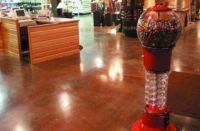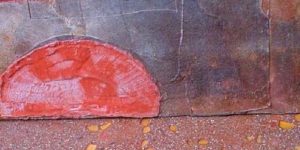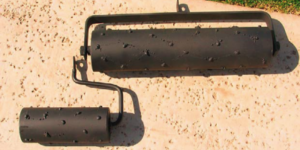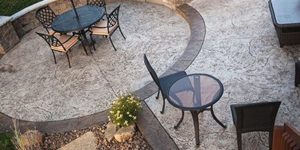BuWithin the concrete industry there is a common misconception that polished concrete means no maintenance, when in reality keeping up a polished floor simply requires low maintenance. Steps must be taken to ensure a completed floor maintains its finished look. With this said, we’ve developed a three-stage process for proper concrete flooring maintenance: restore, protect and maintain.
Stage 1: Restore
Anything that drops and is left on a polished surface may penetrate or stain. Stain protectors remedy this. If a liquid sits, it may also etch the surface, especially if the liquid is citric, acidic or caustic.
This is where restoration comes into play. Concrete is easy to restore by using diamond-impregnated pads, stripping agents, prep tools and specially formulated cleaners. There are a number of products on the market to aid in this step.
Diamond-impregnated pads can be used to remove scratches and stains and leave a clean surface. They vary in grit sizes, so the condition of the floor determines which pad is used. For instance, coarse and medium grits are more aggressive, so they can lighten the floor and may remove dyes.
Water-based stripping agents remove sealers, as does diamond tooling. Cleaners formulated to rejuvenate, on the other hand, remove dirt and return floors to a shiny finish. They also help retain color and prevent damage by working with stain protectors, which will be covered in the second stage.
Stage 2: Protect
The final step in the actual polishing process involves laying down some sort of protection. Stain protectors and guard products sit on top of the floor surface and eventually wear off, although how quickly depends on the type of foot traffic they get over time.
This is why the final step in the floor maintenance process is vital. Stain protectors, guard protectors, densifiers and sealers are effective and crucial for the final polishing step. Depending on the brand, there are different features and benefits, but as a whole, these products deliver exceptional shine, improve surface performance and resist the effects of traffic wear and weathering. In addition, they are formulated to protect polished, dyed concrete from oil and water-based stains as well as acidic etching agents.
However, there is a new stain resister on the market that has a water repellency component. It is a penetrating resister, a fresh concept for this industry because up until now, protection that penetrates, meaning no burnishing is required after application, was uncommon.
The only reason you would burnish this material is if you overapply and have to remove a leftover haze or film, and in this case, a diamond-impregnated pad in conjunction with a burnisher is recommended.
The new stain resister offers better protection and resistance to liquids than the alternatives, but don’t mistake it for a coating. Stains and liquids still must be removed — don’t leave them after spillage or semipermanent damage may result.
You can’t cut corners with this new stain resister if you want to provide a quality flooring finish. Placing a protector during the honing stage and then burnishing instead of actually polishing is an ineffective method that dulls after several months. Rather, you must polish a surface to at least 800 grit if you want the floor to really shine and maintain its image transfer.
Stage 3: Maintain
The final step in the maintenance process is precisely what the name suggests — maintaining, or protecting your investment. Polished and exposed concrete floors are inherently sustainable and very durable, eliminating the need for, and periodic replacement of, applied floor coverings. They are easily cleanable floors with low-impact maintenance requirements, and they eliminate waxing and stripping chemicals, imposing low life-cycle impacts on the environment.
As previously mentioned, though, the type and frequency of maintenance depends on the amount and type of traffic.
A common problem voiced by many people is that they don’t know what is safe to use on polished floors. It is easy to assume standard cleaners are appropriate, when really they only succeed in etching the concrete. Instead, we suggest using products that are void of citric, caustic or acidic components that will ruin the finish. The cleaner should be pH-neutral, and therefore safe for the floor, but be aware that some products are pH-neutral, yet still have one of these caustic components. Reading the label is incredibly important in this regard.
Since polished concrete is wearable, guard products should be reapplied periodically. Again, though, this is determined by the frequency of use and traffic. You will know this is essential once the shine diminishes, making it obvious. Also, if the floor is etched by a stain after the polishing process is complete, there are products that fix this more easily than starting back at the beginning with a grinder. Swing machines, scrubbers, buffers and polishers, for example, can each accomplish this.
There is a huge need in the industry for contractors to maintain polished concrete surfaces, meaning a great opportunity exists. By coming back every month or so, depending on the wear, or every week to clean, you can make residual income and generate continued business even after a polishing job is finished. You can offer a maintenance plan or present a suggested maintenance schedule to customers.















